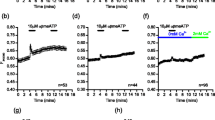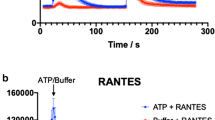Abstract
Adenosine is an important mediator of mast cell secretory responses. Adenosine appears to act through one or more adenosine receptor subtypes to activate several signal transduction pathways; however, the specific mechanisms involved are not clearly defined. We studied the pathways involved in adenosine receptor-mediated calcium fluxes in RBL-2H3 cells, a mucosal mast cell-like line. The role of endogenous heterotrimeric G proteins in adenosine mediated calcium mobilization was investigated by microinjection of inhibitory antibodies that block specific G protein subtype function. The calcium transients associated with adenosine and antigen stimulation were compared in noninjected cells and cells that were microinjected with affinity purified neutralizing antibodies to the α subunits of Gi3, Gq, or Gs. The percentage of cells responding to adenosine was decreased in the presence of antibodies to Gi3 and Gq, but not Gs. Pertussis toxin decreased the percentage of cells responding to adenosine, but not antigen. These studies demonstrated a functional requirement for the pertussis toxin sensitive Gi3 protein and the pertussis toxin insensitive Gq protein in adenosine mediated calcium mobilization in mast cells.
Similar content being viewed by others
REFERENCES
FEOKTISTOV, I. and I. BIAGGIONI. 1995. Adenosine A2b receptors evoke interleukin-8 secretion in human mast cells. J. Clin. Invest. 96:1979–1986.
CHURCH, M. K., P. J. HUGHES, and C. J. VARDEY. 1986. Studies on the receptor mediating cyclic AMP-independent enhancement by adenosine of IgE-dependent mediator release from rat mast cells. Br. J. Pharmacol. 87:233–242.
MARQUARDT, D. L., C. W. PARKER, and T. J. SULLIVAN. 1978. Potentiation of mast cell mediator release by adenosine. J. Immunol. 120:871–877.
MARQUARDT, D. L. and L. L. WALKER. 1987. Alteration of mast cell responsiveness to adenosine by pertussis toxin. Biochem. Pharmacol. 37:4019–4025.
ALI, H., J. R. CUNHA-MELO, W. F. SAUL, and M. A. BEAVEN. 1990. Activation of phospholipase C via adenosine receptors provides synergistic signals of secretion in antigen-stimulated RBL-2H3 cells. J. Biol. Chem. 265:745–753.
WELTON, A. F. and B. A. SIMKO. 1979. Regulatory role of adenosine in antigen-induced histamine release from the lung tissue of actively sensitized guinea pigs. Biochem. Pharmacol. 29:1085–1092.
PEACHELL, P. T., M. COLUMBO, A. KAGEY-SOBOTKA, L. M. LICHTENSTEIN, and G. MARONE. 1988. Adenosine potentiates mediator release from human lung mast cells. Am. Rev. Respir. Dis. 138:1143–1151.
HUGHES, P. J., S. T. HOLGATE, and M. K. CHURCH, 1984. Adenosine inhibits and potentiates IgE-dependent histamine release from human lung mast cells by an A2-purinoceptor mediated mechanism. Biochem. Pharmacol. 33:3847–3852.
CHURCH, M. K., S. T. HOLGATE, and P. T. HUGHES. 1983. Adenosine inhibits and potentiates IgE-dependent histamine release from human basophils by an A2-receptor mediated mechanism. Br. J. Pharmacol. 80:719–726.
RAMKUMAR, V., G. L. STILES, M. A. BEAVEN, and H. ALI. 1993. The A3 adenosine receptor is the unique adenosine receptor which facilitates release of allergic mediators in mast cells. J. Biol. Chem. 268:16887–16890.
RAMKUMAR, V., M. WILSON, D. N. DHANRAJ, T. W. GETTYS, and H. ALI. 1995. Dexamethasone up-regulates A3 adenosine receptors in rat basophilic leukemia (RBL-2H3) cells. J. Immunol. 154:5436–5443.
AUCHAMPACH, J. A., G. H. CAUGHEY, and J. LINDEN. 1995. Molecular cloning and pharmacological characterization of the canine A3 adenosine receptor from BR mastocytoma cells. FASEB J. 9:A122.
BAI T. R., T. WEIR, B. A. M. WALKER, C. A. SALVATORE, R. G., JOHNSON, and M. A. JACOBSON. 1994. Comparison and localization of adenosine A3 receptor expression in normal asthmatic lung. Drug Development Research. 31:244.
MARQUARDT, D. L. and L. L. WALKER. 1990. Modulation of mast cell responsiveness to adenosine by agents that alter protein kinase C activity. Biochem. Pharmacol. 39:1929–1934.
ALI, H., O. H. CHOI, P. F. FRAUNDORFER, K. YAMADA, H. M. S. GONZAGA, and M. A. BEAVEN. 1996. Sustained activation of phospholipase D via adenosine A3 receptors is associated with enhancement of antigen-and Ca2+-ionophore-induced secretion in a rat mast cell line. J. Pharmacol. Exp. Ther. 276:837–845.
HOLGATE, S. T., R. A. LEWIS, and K. F. AUSTEN. 1980. Role of adenylate cyclase in immunologic release of mediators from rat mast cells: agonist and antagonist effects of purine-and ribose-modified adenosine analogs. Proc. Natl. Acad. Sci. 77:6800–6804.
LEOUTSAKOS, A. and F. L. PEARCE. 1986. The effect of adenosine and its analogues on cyclic AMP changes and histamine secretion from rat peritoneal mast cells stimulated by various ligands. Biochem. Pharmacol. 35:1373–1379.
MARQUARDT, D. L. and L. L. WALKER. 1994. Inhibition of protein kinase A fails to alter mast cell adenosine responsiveness. Agents and Actions. 43:7–12.
LOHSE, M. J., K. N. KLOTZ, M. J. SALZER, and U. SCHWABE. 1988. Adenosine regulates the Ca2+ sensitivity of mast cell mediator release. Proc. Natl. Acad. Sci. 85:8875–8879.
OTT, I., M. J. LOHSE, K. N. KLOTZ, I. VOGT-MOYKOPF, and U. SCHWABE. 1992. Effects of adenosine on histamine release from human lung fragments. Int. Arch. Allergy. Immunol. 98:50–56.
MAC GLASHAN, D. 1992. Signal mechanisms in the activation of basophils and mast cells. Immunology Series. 57:273–299.
OLAH, M. E. and G. L. STILES. 1995. Adenosine receptor subtypes: Characterization and therapeutic regulation. Annu. Rev. Pharmacol. Toxicol. 35:581–606.
GOLDSMITH, P., K. ROSSITER, A. CARTER, W. SIMONDS, C. G. UNSON, R. VINITISKY, and A. M. SPIEGEL. 1988. Identification of the GTP-binding protein encoded by G13 complementary DNA. J. Biol. Chem. 263:6476–6479.
SHENKER, A., P. GOLDSMITH, C. G. UNSON, and A. M. SPIEGEL. 1991. The G protein coupled to the thromboxane A2 receptor in human platelets is a member of the novel Gq family. J. Biol. Chem. 266:9309–9313.
MEINKOTH, J. L., P. K. GOLDSMITH, A. M. SPIEGEL, J. R. FERAMISCO, and G. N. BURROW. 1992. Inhibition of thyrotropin-induced DNA synthesis in thyroid follicular cells by microinjection of an antibody to the stimulatory G protein of adenylate cyclase, Gs. J. Biol. Chem. 267:13239–13245.
LA MORTE, V. J., A. T. HAROOTUNIAN, A. M. SPIEGEL, R. Y. TSIEN, and J. R. FERAMISCO. 1993. Mediation of growth factor induced DNA synthesis and calcium mobilization by Gq and Gi2. J. Cell. Biol. 121: 91–99.
YODER, E. J., H. TAMIR, and M. H. ELLISMAN. 1996. 5-Hydroxytryptamine2A receptors on cultured rat schwann cells. Glia. 17:15–27.
KAO, J. P. Y., A. T. HAROOTUNIAN, and R. Y. TSIEN. 1989. Photochemically generated cytosolic calcium pulses and their detection by fluo-3. J. Biol. Chem. 264:8179–8184.
HIDE, M., A. HYDAR, S. RUSS, S. R. PRICE, J. MOSS, and M. A. BEAVEN. 1991. GTP-binding protein Gα L Its down-regulation by dexamethasone and its credentials as a mediator of antigen-induced responses in RBL-2H3 cells. Molec. Pharmacol. 40:473–479.
KUCHTEY, J. and C. FEWTRELL. 1996. Subcloning the RBL-2H3 mucosal mast cell line reduces Ca2+ response heterogeneity at the single-cell level. J. Cell Physiol. 166:643–652.
Author information
Authors and Affiliations
Rights and permissions
About this article
Cite this article
Hoffman, H.M., Walker, L.L. & Marquardt, D.L. Mast Cell Adenosine Induced Calcium Mobilization Via Gi3 and Gq Proteins. Inflammation 21, 55–68 (1997). https://doi.org/10.1023/A:1027390825353
Issue Date:
DOI: https://doi.org/10.1023/A:1027390825353




